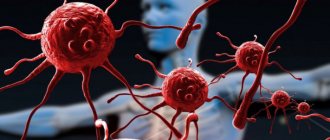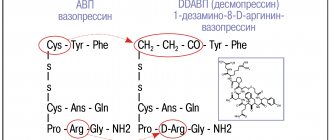- HIV infection
- Causes of AIDS
- How is AIDS not transmitted?
- Pathogenesis
- Symptoms of AIDS
- Forms of flow
- Pulmonary
- Gastrointestinal
- Cerebral
- Disseminated
- Undifferentiated
- Complications of AIDS
- Diagnostics
- AIDS treatment
- Prognosis and prevention
Acquired immunodeficiency syndrome - AIDS, the “plague of the 20th century” - was first identified in the 1980s in the United States. Then cases of death of young men due to pneumonia were recorded. More than 35 million people with AIDS are registered in the world.
HIV infection
AIDS - acquired immunodeficiency syndrome - is a consequence of the development of HIV infection, one of its main markers and is manifested by complete suppression of the immune system. The condition occurs approximately 5 years after infection. Any disease that occurs against the background of HIV can be fatal. Diagnostics is aimed at identifying HIV infection, checking the number of immunocompetent cells and antibodies to the virus. The goal of therapy is to suppress the pathogen through the use of antiviral drugs. It is mandatory to eliminate bacteria, fungi, and viruses that provoke the development of secondary pathologies.
Transmission of infection
HIV can be transmitted through various body fluids of infected people, such as blood, breast milk, semen and vaginal secretions. HIV can also be transmitted from mother to child during pregnancy and childbirth. Normal everyday contact such as kissing, hugging and shaking hands, or sharing personal items and drinking food or water, does not transmit the infection.
It is important to note that virally suppressed HIV-positive individuals receiving antiretroviral therapy (ART) do not transmit HIV infection to their sexual partners. Thus, early access to ART and support for treatment are critical not only to improve the health of people with HIV, but also to prevent HIV transmission.
Causes of AIDS
Human immunodeficiency virus (HIV) is a type of retrovirus. It is found in blood, sweat, vaginal secretions, semen, breast milk, and tears. The infection is transmitted intravenously, from mother to fetus, or sexually. You can become infected with HIV from medical instruments (syringes, etc.) that are used multiple times, during blood transfusions, or when applying tattoos and piercings.
The risk group includes people who have been infected with HIV for more than 5 years, who do not receive proper treatment, injection drug users, pregnant women, people living in unfavorable conditions, people
Prevention measures
Unfortunately, medicine has not yet invented vaccinations and treatments for HIV. Statistics show that today it is not so difficult to become infected, so you need to know about ways to prevent HIV and AIDS:
- Protected sexual intercourse using a condom. In this case, it is necessary to ensure that the condom maintains its integrity until the end of sex and is the right size for the man. Should be worn at the very beginning of contact, and not before ejaculation;
- Regular sexual partner. Having a proven, reliable person is an excellent protection against infection. To be completely sure, both partners can be tested for HIV and immunodeficiency syndrome;
- Don't take drugs. If you already have an addiction, and it is not yet possible to get rid of it, you should use only disposable new syringes and needles, and in no case give them to someone else for injections;
- Women infected with HIV who have given birth to a child should think about how not to infect it, so they should not breastfeed.
The best prevention of AIDS is to start HIV treatment on time. In order to carry out early diagnosis, in order to save the patient’s life and prolong it, tests should be taken at the slightest suspicion of acquired immunodeficiency.
You need to donate blood for AIDS and HIV in the following situations:
- If sexual violence has occurred;
- A current or previous sexual partner has been diagnosed with HIV infection;
- The partner has had sexual intercourse with someone else;
- Use disposable needles and syringes again. You also need to beware of piercings in unverified places, because... there is a risk of infection through piercing and tattooing needles;
- After unprotected oral, vaginal, anal contacts with a new untested partner;
- The presence of any infection that is sexually transmitted.
For the tests to be informative, blood should be donated no earlier than three weeks after the suspected infection. Control tests can be taken after six months, because By this time, antibodies to the virus will definitely begin to be produced. Tests should also be taken if there are signs of HIV and AIDS, even if the patient has not been in any of these situations. It is quite possible to become infected in medical institutions if sterility in handling blood is not maintained.
Pathogenesis
AIDS provokes a gradual decrease in the population of T-lymphocytes (they recognize cells with foreign antigens and play an important role in the acquired immune response), which is caused by a direct cytolytic effect and activation of apoptosis (the process of cell death) in T-helper cells. Leads to deactivation and depletion of the immune pool. HIV infection provokes the destruction of nerve cells and has a toxic effect on neurons. Against the background of decreased immunity, persistent (constantly present) infections are activated. Due to the lack of the necessary response of immunocompetent cells, active reproduction and generalization of the infection occurs.
Why do AIDS-associated diseases develop?
The purpose of the AIDS virus is to disable the body's defense system by destroying immune cells - a special class of lymphocytes called CD4. Lymphocytes perform 2 main functions - protect the body from infection and fight tumor cells. The causative agent of AIDS, in order to avoid death, decides to be the first to attack the body's protective cells. As a result, lymphocytes cease to be lymphocytes, since the virus dictates its DNA to the cell.
Lymphocytes lose their ability to recognize viruses and gradually die. When the level of these lymphocytes decreases to less than 200 cells per 1 μl, resistance to microbes and the ability of immune cells to promptly remove mutating and potentially malignant cells decreases. All disorders in the body associated with the loss of these essential immune functions are referred to as AIDS-associated infections and tumors.
Symptoms of AIDS
From the moment of HIV infection to the first manifestations of acquired immunodeficiency syndrome, years and sometimes decades pass. The patient's condition begins to deteriorate due to the development of other diseases. One of the manifestations is a persistently elevated body temperature, which is accompanied by night chills, flashes of sweat (mainly at night), and a state of delirium. Blue-red nodes, characterized by pain, appear on the lower extremities, oral mucosa, and face (Kaposi's sarcoma).
White cheesy deposits of candida nature may appear on the surface of the mucous membrane and on the skin. There may be difficulty swallowing, a burning sensation in the mouth and a “lump” in the throat, pain in the chest area. There are traces in the form of herpes zoster, vesicles, the condition is accompanied by severe pain, rashes in the form of blisters. The patient complains of lack of appetite, diarrhea, and weight loss is observed - up to 10% of weight in a short period of time.
If the lung tissue is damaged, there is a strong dry cough and shortness of breath. Sometimes among the first symptoms of AIDS are manifestations of damage to the central nervous system: forgetfulness, dementia, severe headaches, decreased concentration, paralysis. Forms of flow
With acquired immunodeficiency syndrome, the patient is easily infected with other infectious diseases. Against the background of reduced immunity, fungi and bacteria spread. Tumors of the skin and internal organs may develop. The manifestation of AIDS differs depending on the clinical form.
Forms of flow
Pulmonary
The most common form of AIDS, present in 50%-80% of adult patients and children. Accompanied by various forms of pneumonia, fever, severe cough, shortness of breath, chest pain. The condition causes oxygen starvation. X-ray shows scattered pulmonary infiltrates. Sometimes pneumonia is accompanied by respiratory failure, intoxication, and tuberculosis may occur. Treatment is carried out according to a complex scheme, which is built in accordance with the patient’s condition.
Gastrointestinal
The second most common form, which affects the intestines. The patient complains of prolonged diarrhea or obstruction, painful swallowing, and chest pain. The gastrointestinal tract is affected not only by associated infections, but also by the HIV pathogen itself. Changes occur not only in housing and communal services, but also in the liver and kidneys. Manifested by stomatitis, colitis, isosporosis, salmonellosis. The main risk is critical weight loss.
Cerebral
A form of HIV infection occurs in 15-20% of patients. NeuroAIDS is characterized by secondary damage to the central nervous system. Brain abscess, meningitis, encephalitis, and multifocal leukoencephalopathy develop. Damage to the central nervous system causes changes in cognitive abilities, behavior, and memory. There is a change in coordination of movements, lethargy, the presence of anxiety, irritation to bright light and loud music. In severe forms, dementia and schizoid manifestations may develop, and in some cases, HIV contributes to the formation of a brain tumor.
Disseminated
Develops in approximately 30% of AIDS cases. It manifests itself as tumors of the skin and mucous membrane, most of the formations are related to Kaposi's sarcoma. A small percentage of HIV-infected people are faced with a malignant tumor - B-cell lymphoma.
Undifferentiated
Clinical form, the etiology of which remains unclear. It manifests itself as prolonged diarrhea, asthenia, lymphadenopathy, purulent foci, and elevated temperature for months. A complex of AIDS-associated symptoms is observed.
Where did AIDS come to us from?
There are several versions of the origin of the disease in the world. The first of them is as follows: human infection occurred in Western America from a monkey. This version is confirmed by the results of HIV analysis. It was initially believed that the source of the HIV virus was the green monkey from Central Africa. While hunting this animal, the virus was transmitted through bite wounds. Therefore, there is speculation about the existence of the virus in animals.
Others suggest that AIDS took place in central Africa, and with few inter-tribal connections the disease did not spread. However, after the growth of cities and communications, the virus spread among the population of other countries.
Many scientists believe that the disease occurs as a result of the use of drugs - LSD, heroin, cocaine - which kill the human immune system. There is also an opinion about the artificial origin of the virus - for example, the version according to which American scientists working with bacteriological weapons created the AIDS virus.
Many scientists are still trying to turn a virus that destroys the human immune system into a universal vaccine. They suggest that by changing its structure, it is possible to save humanity from many terrible diseases - not only AIDS, but also malignant tumors.
Complications of AIDS
People with acquired immunodeficiency syndrome are at risk of developing tuberculosis. Most of these patients have a generalized form of tuberculosis, which can lead to death and disability. Up to 90% of AIDS patients suffer from Pneumocystis pneumonia, and 10% have damage to the central nervous system. Up to 23% of cases of tuberculous meningoencephalitis are registered.
All HIV-infected people are at risk of developing candidal pharyngitis, regardless of the stage of the disease. A tenth of patients have a fungal infection of the esophagus; the patient’s condition worsens due to a decrease in T-helper cells.
AIDS
The main difference between HIV and AIDS is the method of infection. AIDS is the last stage of HIV infection, and in contrast to it, it is an acquired syndrome. The danger to the patient's life is that any infection and AIDS are incompatible. At the same time, such people lose weight, they constantly suffer from various diseases: stomatitis, frequent exacerbations of herpes, lichen, ENT infections. Against the background of progressive thrombocytopenia (decreased platelet concentration), hemorrhagic hemorrhages appear, and the gums begin to bleed. People with AIDS begin to look permanently sick. This is followed by more severe infections: toxoplasmosis, pneumonia, tuberculosis, neurological pathologies, cancer, and many others.
So, we have found out the basic concepts about HIV and AIDS, and what is the difference between them. In addition, you need to figure out how to avoid getting sick from these dangerous diseases.
Every person should know how AIDS is transmitted in order to protect themselves and their loved ones:
- Sexual contacts with immunodeficient patients. Infection occurs through sperm. The risk increases with diseases such as urethritis and epididymitis, because during this period the semen contains many more infected cells. In addition, the presence of other sexually transmitted infections is characterized by disruption of the mucous membrane and the appearance of ulcers, blisters, etc. The disease can also be transmitted through them. Anal and oral contact are also ways of transmitting infection;
- From mother to child. Viral cells can be transmitted to the fetus through the placenta, as well as during childbirth. In addition, the child may become ill after childbirth; the virus is contained in breast milk, so infected women must stop breastfeeding;
- Contacts of medical personnel with patients. Moreover, infection can occur both from the second to the first, and vice versa. If the integrity of the skin was broken by instruments containing particles of the blood of an HIV-infected person, this will lead to infection;
- From donor blood or other substances (plasma, platelet mass, etc.). The exception is immunoglobulins, because they undergo special cleansing before insertion;
- When drug addicts use one syringe and needle for two or even three.
Diagnostics
The diagnosis of AIDS is made after consultation with an infectious disease specialist. If there are concomitant diseases, other medical specialists are involved. Patients with HIV infection are mostly advised by phthisiatricians. The following methods are used to diagnose the disease:
- Physical. A medical examination is aimed at identifying signs of the disease, in particular, the growth of lymph nodes, changes in behavior, rashes on the mucous membranes and skin. Rhythm disturbances and noises may be heard in the heart, and snoring in the lungs. White plaque may be present in the oral cavity.
- Ophthalmological. Signs of the disease are retinal necrosis, precipitates in the anterior chamber, and nerve atrophy. The patient complains of decreased sharpness and the formation of spots before the eyes.
- Laboratory. Shows the main manifestations of immunodeficiency: thrombocytopenia, anemia, leukopenia, lymphopenia. Clinical urine analysis shows proteinuria, lipiduria. The screening method allows you to determine the immune blot. PCR testing is used to identify antigens.
- Instrumental. Includes chest x-ray, MSCT, MRI of the brain and mediastinal tomography. For all patients with HIV, ultrasound of the kidneys, abdomen, and pelvis is recommended.
- Differential diagnosis. It is carried out in the presence of clinical symptoms. Skin manifestations are similar to those of allergic dermatitis, syphilis, and herpes zoster. Enlarged lymph nodes are detected with tuberculosis and brucellosis.
AIDS treatment
The advisability of treatment in a hospital will be determined by the patient’s condition. Hospitalization in highly specialized medical institutions is possible: oncology and tuberculosis dispensaries. In some cases, hospitalization in intensive care is necessary. For concomitant diseases, such as hepatitis, diabetes, a patient with symptoms of AIDS is prescribed a diet. Bed rest is necessary for prolonged fever.
Etiotropic antiretroviral drugs prevent the progression of HIV infection. The action is aimed at reducing the amount of virus in the blood. Antiviral, antifungal and antibacterial agents are used to treat concomitant infections. If indicated, radiation and chemotherapy are performed; surgery may be required. To relieve symptoms, medications are taken to reduce fever, detoxification, and vasoprotective agents.
Treatment
Patients with the immunodeficiency virus can live quite a long time, provided they are constantly monitored by doctors and take medications. Therapy is aimed at maintaining the concentration of lymphocytes, as well as preventing opportunistic infections. If the immune system is in normal condition, then there is no danger of AIDS.
When immunodeficiency syndrome is detected, the patient must follow many rules and restrictions in order to prolong his life. Contacts with strangers, stray animals, and communication with sick and cold people are excluded only by observing precautionary measures. It is necessary to get rid of bad habits and also maintain a balanced diet. A little exercise will help support your immune system.
The most important thing that distinguishes HIV from AIDS, of course, is that as long as the virus has not affected the immune system so much that it can no longer fight enemies, it is possible to maintain a person in a state of almost complete health. The only thing that a person diagnosed with HIV should not forget about is timely treatment prescribed by doctors, as well as precautions when contacting healthy people so as not to infect them. Everyone who comes into contact with infected people should know the basic concepts about HIV infection and AIDS.
Prognosis and prevention
The prognosis will depend on the timeliness of detection of HIV and opportunistic pathologies. With the help of antiretroviral drugs it will be possible to prevent the appearance of systemic forms. With HIV infection, tuberculosis leads to death in 50% of cases, toxoplasmosis and pneumystosis - in 17%, CMV infection (cytomegalovirus infection) - in 15%. Other conditions are less likely to cause mortality. If an opportunistic pathology (except tuberculosis) is detected, patients are prescribed two-week antiretroviral therapy.
Work is underway to create a vaccine that prevents HIV infection, but the main difficulty lies in the constant mutation of the virus. As nonspecific preventive measures, it is recommended to abstain from unprotected sexual intercourse (sexual intercourse without a condom) and drug use. At the state level, it is required to introduce educational programs related to HIV infection, disseminate information through the media and social events.
Transmission routes
HIV infection
— anthroponosis. Animals do not become infected with HIV-1 under natural conditions, and attempts to experimentally infect monkeys result in their rapid recovery.
The source of HIV infection is an infected person at any stage of the disease, including the incubation period.
HIV transmission is most likely from a person at the end of the incubation period, during the period of primary manifestations and in the late stage of infection, when the concentration of the virus reaches its maximum.
HIV infection is a long-term disease. From the moment of infection to the moment of death without highly active antiretroviral therapy, it can take from 2-3 to 10-15 years. Naturally, these are average indicators.
The human immunodeficiency virus can be found in all biological fluids (blood, semen, vaginal secretions, breast milk, saliva, tears, sweat, etc.), and overcomes the transplacental barrier. However, the content of viral particles in biological fluids is different, which determines their unequal epidemiological significance. The human immunodeficiency virus infects all cells that have the CD4+ receptor. Tropism for CD4+ T lymphocytes leads to the progression of HIV infection due to the development of immunodeficiency. In the body of an infected person, HIV is found in various environments and tissues. For example, lymphoid tissue in the brain and internal organs.
Human biological substrates containing HIV and having the greatest epidemiological significance in the spread of HIV infection:
- blood
- sperm and precum
- vaginal and cervical secretions
- mother's breast milk
The virus may also be present in other substrates (but its concentration in them is low or the substrate is inaccessible, such as cerebrospinal fluid):
- cerebrospinal fluid (CSF)
- urine
- saliva
- tear fluid
- secretion of the sweat glands
The different content of HIV in biological fluids determines their epidemiological significance as factors implementing the route of transmission of the pathogen.
Susceptibility to HIV in humans is universal and is determined by the geno- and phenotypic polymorphism of individuals, which can manifest itself either in complete (or incomplete) limitation of the possibility of HIV infection, or in an acceleration or decrease in the rate of development of clinical symptoms of infection.
In the course of an epidemiological analysis of the global situation with respect to HIV infection, it was found that there are certain interracial differences in the dynamics of infection and progression of HIV infection, with the dominant role played by antigens of the major histocompatibility complex. It turned out that the most sensitive (susceptible) to HIV were representatives of the Negroid race, less - Europeans and least - Mongoloids.
Currently three genes have been described (CCR5, CCR2 and SDF1)
, controlling the synthesis of molecules and participating in the penetration of HIV into host cells, i.e. people with a homozygous form for these genes are resistant to sexually transmitted HIV infection, while those with a heterozygous form are somewhat less resistant. However, this symptom is not associated with immunity to HIV through blood transfusions and parenteral substance use.
For HIV transmission, it is necessary not only to have a source of infection and a susceptible subject, but also to have the appropriate conditions to ensure this transmission. On the one hand, the release of HIV from an infected organism in natural situations occurs in limited ways: with sperm, genital secretions, breast milk, and in pathological conditions - with blood and various exudates. On the other hand, for HIV infection with the subsequent development of the infectious process, the pathogen must enter the internal environment of the body.
HIV transmission is carried out by the following mechanisms: natural - contact, vertical and artificial (artificial). The ways of implementing the mechanisms of transmission of the pathogen are varied: sexual, transplacental, parenteral (injection, transfusion, transplantation). The dominant mechanism of transmission of the pathogen is contact, through sexual contact. The leading role of sexual transmission is due to the high concentration of the virus in the semen and vaginal secretions of infected individuals.
It is believed that sexual transmission of the virus accounts for 86% of all cases of infection, of which 71% are through heterosexual and 15% through homosexual contacts. The reality of HIV transmission in the male-to-male, male-to-female and female-to-male directions is generally accepted. At the same time, the ratio of infected men and women varies. At the beginning of the epidemic this ratio was 5:1
, then
3:1
, now in Russia this figure is close to
1.7:1
.
The vertical mechanism of HIV transmission occurs in infected pregnant women (antenatal route). Infection of a child can occur during childbirth (intranatal route), and then postnatally, during breastfeeding.
The main route of HIV infection in newborns is perinatal. The proportion of HIV transmission at different times of the perinatal period is not precisely determined, however, intrauterine infection in early pregnancy occurs in 30-50% of cases in the absence of prevention of perinatal HIV transmission.
The likelihood of a baby becoming infected while breastfeeding is about 12-20%. Moreover, transmission of the virus can occur not only from an infected mother to a child, but also from an infected child to a nursing woman if a child born to a healthy woman was infected with HIV, as was described during the epidemiological investigation of a nosocomial outbreak in Elista.
The immunodeficiency virus is transmitted through the transfusion of infected whole blood and products made from it (erythrocyte mass, platelets, fresh and frozen plasma). When blood is transfused from HIV-seropositive donors, recipients become infected in 90% of cases. Normal human immunoglobulin and albumin are not dangerous because The technology for producing these drugs and the stages of raw material control exclude HIV infection.
Relatively rare but possible variants of infection are organ and tissue transplantation and artificial insemination of women.
Transmission of HIV by airborne droplets, food, water, and vector-borne routes has not been proven.
An “artificial” (artificial) mechanism is triggered during medical procedures accompanied by a violation of the integrity of the skin and mucous membranes, i.e. nosocomial HIV infection occurs. This mechanism has various routes and factors of transmission of the pathogen, however, in HIV infection, the role of this mechanism of HIV spread is negligible.
An example of the implementation of an artificial mechanism for the spread of HIV infection is the nosocomial infection of children with HIV in the cities of Elista, Rostov-on-Don, and Volgograd.
Currently, this route of spread of HIV infection is not being implemented due to the fact that strict control of blood products and all invasive diagnostic interventions has been introduced, subject to pre-sterilization cleaning and sterilization of medical instruments, and the use of disposable medical instruments (for example, syringes).
However, parenteral (“syringe”) transmission of HIV is quite widespread among drug addicts who use intravenous psychoactive substances.
The degree of risk of HIV infection is not the same for different groups of the population; accordingly, it is possible to identify contingents at high risk of infection: homo-, bisexuals, “injecting drug addicts”, recipients of blood and its products, prostitutes, tramps, supporters of free love, hotel staff, international air lines, military personnel, sailors, immigrants, refugees, seasonal workers, tourists.
The role and significance of these risk factors are ambiguous; their combined action is often noted, and it is not possible to isolate the leading one from a single set of risk factors operating in the territory at a given time.






